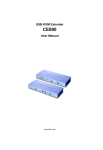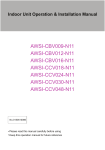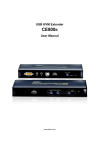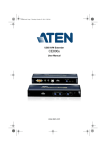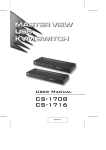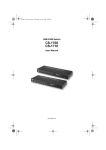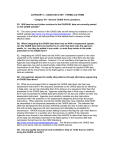Download ATEN CE800 Installation guide
Transcript
Installation Guide KVM Extender with on board audio GCE800W6 1 Part No. M0577 Overview The GCE800 USB KVM Extender with on board audio allows access to a computer system from a remote console (USB keyboard, mouse, monitor, stereo speakers, and microphone). It is perfect for factory and construction sites, or any type of installation where the console needs to be in a conveniently accessible location, but you want the system equipment to reside in a safe place - away from dust, dirt, and harsh environmental influences. The GCE800 also is useful for control and security purposes. Store the system unit in a secure area at the same time that you put the console in a location that offers convenient access. Recognizing the increased importance of sound in the computing environment, the GCE800 improves on earlier models by incorporating audio capability. Now, audio (stereo microphone and stereo speakers) transmission can be extended to the remote system along with the KVM data. The GCE800 USB KVM Extender improves on previous designs by using compact Cat 5 cable - the kind commonly used in Ethernet networks which makes for a much neater, more convenient, more reliable data transfer connection. In addition, the GCE800 has a built-in USB port that complies with the USB Mass Storage specification and supports USB Mass Storage compliant flash drives. Setup is as easy as can be: simply connect the computer system and local console components to the local GCE800 module, run the Cat 5 cable to the Remote GCE800 module (up to 820 ft) ; and connect the console to the Remote Module. Note: Y . ou can control numerous remote systems from a single console by combining the GCE800 with a KVM switch. 3 Table of Contents Overview 3 Keyboard Emulation 40 Package Contents 5 The Firmware Upgrade Utility 42 Features 6 Administrator Password 49 System Requirements 7 Appendix 50 Hardware Introduction 11 Specifications 55 Hardware Setup 15 Troubleshooting 59 Installation 17 User Notice 60 Operation 19 61 LED Display 22 Federal Communications Commission (FCC) Statement CE Statement OSD Operation 25 Limited Warranty 63 Contact 64 OSD Navigation 27 Hotkey Operation 33 4 Package Contents The CE800 Audio KVM Extender package contains: • 1 CE800L KVM Extender (Local Unit) • 1 CE800R KVM Extender (Remote Unit) • 1 Custom KVM 6 ft (1.8 m) Cable • 2 Power Adapters • 1 Firmware Upgrade Cable • 1 Rack Mount Kit • 1 User Manual • 1 Quick Start Guide Check to make sure that all the components are present and that nothing was damaged in shipping. If you encounter a problem, contact your dealer. Read this manual thoroughly and follow the installation and operation procedures carefully to prevent any damage to the unit, and/or any of the devices connected to it. 5 Features • Uses Cat 5 ( or better) to connect the Local and Remote Units – up to820 ft (250 meters) apart • Control your system from either the local or remote consoles • Pushbutton selection can lock control to either computer • Built-in USB ports on both units support USB mass storage devices for simple file transfer • Configurable security requires user name and password to mount USB storage devices • Supports VGA, SVGA, and multi-sync monitors • The local unit supports DDC, DDC2, and DDC2B monitors • High Resolution Video – up to 1600 x 1200 @ 60 Hz • Built-in 8KV ESD protection and 2KV surge protection • Manually adjustable gain control for distance compensation. • Supports microphone and powered stereo speakers • Supports most two button scroll wheel mice • Up gradable firmware 6 System Requirements Consoles ( 1 each per console ) • A VGA, SVGA, or Multi-sync monitor capable of the highest resolution you want to use • A USB style keyboard • A USB style mouse • A Microphone and Stereo Speakers (optional) Note: If you connect a DDC type monitor to the Local unit, the monitor that connects to the Remote unit must be able to support the highest video resolution that the DDC monitor can provide Computers •A VGA, SVGA or Multi-sync card • A USB Host Controller and Type A USB Port • Audio out (optional ) KVM •VGA / SVGA support • A USB Host Controller and Type A USB Port • Hot key or OSD ( On Screen Display) switching • Audio Support (optional) 7 Operating Systems • Windows 2000 and higher • Redhat 7.1, 7.2, 7.3, 8.0 and higher • Mandrake 9.0 and higher • SUSE 8.2 and higher • FreeBSD 4.2, 4.3, 4.5 and higher • Netware 6.0 and higher Cables For optimum signal integrity and to simplify the layout, we strongly recommend that you use the high-quality Custom USB KVM Cable that is provided with this package. Cat 5 cable is the minimum required to connect the local and remote CE800 units. Cable of a lower standard may result in degraded video signals. For best performance, we strongly recommend at least Cat 5 cable. 8 CE800L (Local Unit) Front View Supported operating systems are shown in the table, below: 1 2 3 9 4 5 No. Component Description 1 KVM Port Section This section is made up of a microphone jack, speaker jack and KVM (keyboard, video, mouse), data connector. The cable that links the CE800L to your local KVM console plugs in here. Only KVM cables designed to work with this switch can be used. 2 Audio connections microphone and speakers connect here 3 USB Port External USB Mass Storage compliant flash drives plug into this port.. 4 Operating Mode Selection Switch Pressing this switch toggles the operating mode between Auto and Local. See Mode Selection, page 11 for details 5 Remote LED 6 Local LED The Local Unit has two LEDs to indicate the operating status of the Local and Remote units (see LED Display, page 12 for details). 10 Safety Instructions GCE800R (Remote Unit) Front View 2 1 Picture Compensation LINK 3 11 4 5 6 No. Component Description 1 USB Peripheral Port External USB Mass Storage compliant flash drives plug into this port. 2 Picture Compensation Switches These switches adjust the picture quality of the remote console. See Picture Compensation, page 12 for details. 3 Picture Compensation LED Flashes to indicate that picture quality has been adjusted. See Picture Compensation, page 12 for details. 4 Operating Mode Selection Switch Pressing this switch toggles the operating mode between Auto and Remote. See Mode Selection, page 11 for details. 5 Remote LED The Remote LED indicates the operating status of the Remote unit (see CE800R (Remote Unit):, page 13, for details). 6 Link LED Lights to indicate that the CE800R is connected to the CE800L 12 GCE800L / GCE800R Rear View 2 1 4 5 13 3 6 No. Component Description 1 Power Jack The cable from the DC Power Adapter plugs into this jack.t 2 Keyboard and Mouse Ports The console USB keyboards and mice plug into these ports. The ports are color coded and marked with an icon to identify themselves. 3 Link Port The Cat 5 cable that connects plugs into this connector. 4 Firmware Upgrade Port (CE800L only The Firmware Upgrade Cable that transfers the firmware upgrade data from the administrator’s computer to the CE800L plugs in here. 5 Console Audio Jacks The stereo microphone and stereo speakers plug into these connectors. The ports are color coded and marked with an icon to identify themselves. 6 Video Port The console monitors plug into these ports. 14 Hardware Setup Before You Begin Conventions This manual uses the following conventions: Monospaced Indicates text that you should key in. [] Indicates keys you should press. For example, [Enter] means to press the Enter key. If keys need to be chorded, they appear together in the same bracket with a plus sign between them: [Ctrl+Alt]. 1. Numbered lists represent procedures with sequential steps. Bullet lists provide information, but do not involve sequential steps. Indicates selecting the option (on a menu or dialog box, for example), that comes next. For example, Start Run means to open the Start menu, then select Run means to Start menu, and then select Run. Indicates critical information. 15 Safety 1. Important safety information regarding the placement of this device is provided on page 51. Please review it before proceeding. 2. Make sure that power to all the devices you will be connecting up have been turned off. You must unplug the power cords of any computers that have the Keyboard Power On function. 16 Installation Setting up the USB KVM Extender System is simply a matter of plugging in the cables. Refer to the diagram on the next page as you perform the following steps 1. Plug the cables from the local console devices (mouse, keyboard, monitor, microphone and speakers) into their ports on the rear panel of the Local Unit (CE800L). The connectors are color coded and marked with an icon for identification. 2. Connect the custom KVM cable provided to the KVM port on the CE800L’s front panel. 3. Connect the other end of the KVM cable into the appropriate ports on the computer system (or Console section of the KVM switch). The connectors are color coded and marked with icons for identification. 4. Connect one end of an ethernet cable to the Link port on the CE800L; then connect the other end to the Link port on the CE800R. Note: Ethernet cable is not supplied with this package. It requires a separate purchase. The cable length can be up to 250 m (820’). 17 5. Connect the cables from the remote console devices to their ports on the rear panel of the remote unit (CE800R). 6. Connect one of the power adapters (provided) to an AC source; connect the adapter’s power cable to the Power Jack on the CE800L. 7. Connect the other power adapter (provided)to an AC source; connect the adapter’s power cable to the Power Jack on the CE800R. 4 CE-800L 1 6 CE-800L 2 CE-800R 7 3 5 18 Operation Basic Operation Operating Modes The CE800 USB KVM Extender utilizes three operating modes: Auto, Local, and Remote, as described in the table below: Mode Description Local Only the local console has complete access.* Remote Only the remote console has complete access.* Auto Neither console has keyboard and mouse input control. The first console to initiate key board or mouse command assumes control. Following this, if there is no input for five seconds, the CE800 reverts to Auto Mode. 19 Mode Selection The Operating Mode Selection Switch, located on each unit’s front panel, controls the operating mode of the CE800 USB KVM Extender system. Pressing the switch toggles the operating mode as follows: Switch Action Local (CE800L) Selection Switch Only the local console has keyboard and mouse control the computer Remote (CE800R) Selection Switch Only the remote console has keyboard and mouse control the computer 20 When the system is in Local Mode, the Remote unit’s selection switch is inactive. Pressing it has no effect – the Remote operator cannot take over control. The Remote selection switch only becomes active after the Local selection switch is pressed to return the system to Auto Mode. Likewise, if the system is in Remote Mode, the Local unit’s selection switch is inactive – the Local operator cannot take over control. The Local selection switch only becomes active after the Remote selection switch is pressed to return the system to Auto Mode. Picture Compensation The quality of the video display can deteriorate with distance. The Picture Compensation switches adjust the picture quality of the remote console. If it becomes necessary to adjust the video signal, press the plus button (+) to increase the video signal gain; press the minus button (-) to decrease the video signal gain. The Picture Compensation LED blinks until compensation has completed, at which time it remains illuminated. 21 LED Display The GCE800 Local and Remote Units have front panel LEDs to indicate their operating status, as shown in the table below: GCE800L (Local Unit): LED Local Remote Status Indication Off Local Mode is in effect. The Local console has keyboard and mouse input control. Flashing Remote Mode is in effect. The Remote console has keyboard and mouse input control. On Auto Mode is in effect. The first console to establish keyboard or mouse input takes control. Off Remote Mode is in effect. The Remote console has keyboard and mouse input control. Flashing Local Mode is in effect. The Local console has keyboard and mouse input control. Auto Mode is in effect. The first console to establish keyboard or mouse input takes control. 22 GCE800R (Remote Unit): LED Status Indication Remote On Remote Mode is in effect. The Remote console has input control. Off Local Mode is in effect. The Local console has input control. Flashing Auto Mode is in effect. The first console to initiate a command assumes control On The CE800R is connected to the CE800L. Off The CE800R is not connected to the CE800L. Flashing A picture compensation button has been pushed (+ or –) and the CE800 is adjusting the gain. Steady Gain adjustment has been completed and saved. Link Compensation 23 USB Mass Storage Both the CE800L and the CE800R have a built-in USB port that complies with the USB Mass Storage specification and supports USB Mass Storage compliant flash drives. When you connect a USB Mass Storage complaint flash drive into either unit’s USB port, it appears as a removable drive on the computer. As a security measure, if a flash drive is connected to the Remote unit, the OSD login screen appears (see OSD operation no the next page). The operator must log in with a valid username and password before continuing. 24 OSD Operation Overview The CE800 USB KVM Extender provides a convenient menu driven On Screen Display (OSD) to handle its configuration parameters. All procedures start from the OSD Main Screen. To access the Main Screen: 1. Tap the OSD Hotkey (Scroll Lock) twice. Note: [Scroll Lock] is the default OSD hotkey. You can change the hotkey to the Ctrl key (see OSD HOTKEY, page 35, and see Alternate OSD Activation Keys, page 36). The login dialog box appears: 25 2. Key in a valid username and password, then press [Enter]. Note: If this is the first time that the OSD is being run, or if the password function has not been set, simply press [Enter]. The OSD Main Screen comes up in Administrator Mode. In this mode, you have Administrator privileges, which provides access to the configuration parameters Administrator Main Screen After you log in to the OSD, if you are the administrator, a screen similar to the one below appears: Note: If you are an ordinary user, see User Configuration, page 32 26 OSD Navigation The following principles govern the way you navigate through the OSD: To dismiss the menu, and deactivate the OSD, Click the X at the upper right corner of the OSD Window; or press [Esc]. To move up or down through the list one line at a time, Click the Up and Down Triangle symbols use the Up and Down Arrow Keys on your keyboard. or To select a menu item click it or move the highlight bar to it with the arrow keys, then press [Enter]. If a submenu appears, make your choice either by double clicking it, or moving the highlight bar to it, then pressing [Enter]. An icon of a pointing finger indicates the currently selected choice. 27 Administrator Configuration The administer configuration settings are listed below: Setting Function This function is used to set Usernames and Passwords for the Administrator and Users: 1. One Administrator and four User passwords can be set. SET USERNAME AND PASSWORD 2. After you select the Administrator field or one of the User fields, a screen that allows you to key in your username and password appears. The username and password may be up to 12 characters long, and can consist of any combination of letters and numbers. 3. For each individual, key in the Username and Password, then press [Enter]. To modify or delete a previous Username and/or Password, use the backspace key to erase individual letters or numbers. OSD HOTKEY Selects which Hotkey activates the OSD function: [Scroll Lock] [Scroll Lock] or [Ctrl] [Ctrl]. 28 Setting HOTKEY COMMAND MODE Function Enables / Disables the Hotkey Command function. If the hotkey combinations conflict with programs running on the computers, you may want to disable hotkey operation by turning Hotkey Command Mode Off. The default is On Selects which combination activates Hotkey Setting HOTKEY Mode (HSM): [Num Lock] + [–] or [Ctrl] + [F12] The default is [Num Lock] + [–] USER If this setting is On, users have to provide a Username AUTHENTICATION and Password when they plug a flash drive into the USB port of the Remote unit. The default is On. 29 Setting Function RESTORE DEFAULT VALUES Selecting Y (Yes) undoes all changes and returns the CE800’s setup to the original factory SET OPERATING This function specifies the operating platform of the computer attached to the CE800L. Choices are Win, Mac, Sun, and SPC*. The default is Win SYSTEM SET KEYBOARD LANGUAGE default settings.1 Selects the keyboard layout used by the computer connected to the CE800. Choices are Auto, English,French, German, and Japanese. Auto automatically detects the keyboard layout set for the computer and sets the CE800 accordingly. The default is Auto. 1You must be logged on as Administrator to restore factory defaults. To reset a forgotten Administrator password see page 50 * SPC stands for Special Case. For certain operating systems (such as FSBD), you may need to choose this option if you run into startup problems. 30 User Configuration The CE800 USB KVM Extender supports up to four user accounts in addition to the administrator. When users invoke the OSD, they get an OSD Main screen allows them to modify some of the configuration settings made by the administrator. The User OSD Main Screen looks similar to the one, below: 31 The configuration settings that users are allowed to make are explained in the table below: Setting CHANGE PASSWORD HOTKEY COMMAND MODE Function Users can use this function to change the password that was assigned to them by the administrator. These settings are the same as the ones described under Administrator Configuration, page 29. HOTKEY SET OPERATING SYSTEM 32 Hotkey Operation In addition to the OSD, the administrator and users can also use hotkey combinations to configure a number of the CE800 USB KVM Extender’s working environment parameters. Invoking Hotkey Mode All Hotkey operations begin by invoking Hotkey Mode (HKM). To invoke Hotkey Mode, do the following: 1. Hold down the Num Lock key 2. Press and release the minus key 3. Release the Num Lock key [Num Lock] + [-] Note: There is an alternative key combination to invoke HKM (see Alternate Hotkey Invocation Keys, page 35). 33 When Hotkey Mode is active: • The Caps Lock, and Scroll Lock LEDs flash in succession to indicate so. They stop flashing and revert to normal status when you exit HKM. • A Command Line appears on the monitor screen. The command line prompt is the word Hotkey: in yellow text on a blue background. Hotkey information that you key in displays on the command line. • Ordinary keyboard and mouse functions are suspended – only Hotkey compliant keystrokes and mouse clicks (described in the sections that follow), can be input. • At the conclusion of some hotkey operations, you automatically exit hotkey mode. With some operations, you must exit manually. To exit HKM manually, press [Esc] or [Spacebar]. Alternate Hotkey Invocation Keys An alternate set of hotkey invocation keys is provided in case the default set conflicts with programs running on the computers. 34 To switch to the alternate hotkey invocation set, do the following: 1. Invoke HKM (see page 19) 2. Press and release the H key The hotkey invocation keys become the Ctrl key (instead of Num Lock) and the F12 key (instead of Minus). Note: This procedure is a toggle between the two methods. To revert back to the original [Num Lock] [Minus] method, invoke HKM, then press and release the H key again. Alternate OSD Activation Keys The OSD activation method can be changed from tapping the Scroll Lock key twice to tapping the Ctrl key twice ([Ctrl] [Ctrl]). To change the OSD activation method, do the following: 1. Invoke HKM (see page 19) 2. Press and release the T key 35 Note: 1. This procedure is a toggle between the two methods. To revert back to the original [Scroll Lock] [Scroll Lock] method, invoke HKM, then press and release the T key again. 2. For Mac systems we recommend using [Ctrl] [Ctrl] as the OSD activation keys since Scroll Lock is used to emulate F14 in PC to Mac keyboard emulation (see Keyboard Emulation, page 23). Enable / Disable Hotkeys In case a conflict occurs with programs running on the computer, you may wish to disable the hotkey function. To disable the hotkey function do the following: 1. Invoke HKM (see page 19) 2. Press and release the X key Note: This procedure is a toggle between enabling / disabling the hotkey function. To revert back to the original enabled status, invoke HKM, then press and release the X key again. 36 Keyboard Operating Platform The CE800’s default configuration is for a PC Compatible keyboard operating platform. If you have a Mac or a Sun on your installation, you can change the keyboard operating platform as follows: 3. Invoke HKM (see page 19) 4. Press and release the appropriate Function key (see table). Key [F1] Operation Sets the PC Compatible keyboard operating platform for the port that currently has the KVM focus [F2] Sets the Mac keyboard operating platform for the port that currently has the KVM focus. [F3] Sets the Sun keyboard operating platform for the port that currently has the KVM focus. 37 Note: 1. The brackets indicate the keys you should press. Simply press the indicated keys - do not type the brackets. 2. After completing a setting, you automatically exit HKM. USB Reset Sometimes the USB keyboard and mouse connection to the CE800 needs to be reset. Instead of unplugging and re-plugging them, a hotkey combination can perform the reset, as follows: 1. Invoke HKM (see page 19) 2. Press and release the F5 function key. 38 Hotkey Summary Table [Num Lock] + [–] or [H] Toggles between the default ([Num Lock] [–]) and alternate ([Ctrl] [F12]) Hotkey invocation keys. [T] Toggles between the default ([Scroll Lock] [Scroll Lock]) and alternate ([Ctrl] [Ctrl]) OSD invocation keys. [X] Toggles between Enabling / Disabling the hotkey function. [F1] Sets the PC Compatible keyboard operating platform for the port that currently has the KVM focus. [F2] Sets the Mac Compatible keyboard operating platform for the port that currently has the KVM focus. [F3] Sets the Sun keyboard operating platform for the port that currently has the KVM focus. [F5] Resets the USB keyboard and mouse. [Ctrl] + [F12] 39 Keyboard Emulation Mac Keyboard The PC compatible (101/104 key) keyboard can emulate the functions of the Mac keyboard. The emulation mappings are listed in the table to the right Note: When using key combinations, press and release the first key (Ctrl), then press and release the activation key. 40 Sun Keyboard The PC compatible (101/104 key) keyboard can emulate the functions of the Sun keyboard when the Control key [Ctrl] is used in conjunction with other keys. The corresponding functions are shown in the table below. Note: When using key combinations, press and release the first key (Ctrl), then press and release the activation key 41 The Firmware Upgrade Utility The Windows-based Firmware Upgrade Utility (FWUpgrade.exe) provides a smooth, automated process for upgrading the Extender’s firmware. The Utility comes as part of a Firmware Upgrade Package. New firmware upgrade packages will be posted on our web site as they become available. Check the web site regularly to find the latest packages and information relating to them: http://www.aten.com To prepare for the firmware upgrade, do the following: 1. Unplug the power adapters from both units, and disconnect the KVM cable (to the local computer) from the CE800L’s front panel. 2. Go to our Internet support site and choose the model name that relates to your device (CE800) to get a list of available Firmware Upgrade Packages. 42 3. Choose the Firmware Upgrade Package you want to install (usually the most recent), and download it to your computer. 4. Use the Firmware Upgrade Cable provided with this unit to connect a COM port on your computer to the CE800L’s Firmware Upgrade Port 43 5. Make sure both units are connected by the Cat 5 cable, then plug in the Remote unit’s power adapter. 6. Press and hold the Local unit’s Selection button, then plug in the Local unit’s power adapter. 7. Wait until both green front panel LEDs on the Local unit are flashing on and off, then release the Selection button. 8. Make sure the orange LED on the front panel of the Remote unit is on (indicating that Firmware Upgrade Mode is in effect. Note: If the LED is not on, or it is blinking, the unit is not ready to be upgraded. You must repeat steps 6 and 7. Starting the Upgrade To upgrade your firmware: 1. Run the downloaded Firmware Upgrade Package file - either by double clicking the file icon, or by opening a command line and entering the full path to it. 44 The Firmware Upgrade Utility Welcome screen appears: Note: The screens shown in this section are for reference only. The wording and layout of the actual screens put up by the Firmware Upgrade Utility may vary slightly from these examples. 2. Read and Agree to the License Agreement (enable the I Agree radio button). 45 3. Click Next to continue. The Firmware Up grade Utility main screen appears: The Utility inspects your installation. All the devices capable of being upgraded by the package are listed in the Device List panel. 4. As you select a device in the list, its descrip tion appears in the Device Description panel. 46 5. After you have made your device selection(s),Click Next to perform the upgrade. If you enabled Check Firmware Version, the Utility compares the device’s firmware level with that of the upgrade files. If it finds that the device’s version is higher than the upgrade version, it brings up a dialog box informing you of the situation and gives you the option to Continue or Cancel. 47 Upgrade Succeeded After the upgrade has completed, a screen appears to inform you that the procedure was successful: Click Finish to close the Firmware Upgrade Utility. After successfully upgrading the firmware, the switches automatically exit Firmware Upgrade Mode. Upgrade Failed If the Upgrade Succeeded screen does not appear, then the upgrade failed to complete successfully. You should repeat the upgrade procedure from the beginning. 48 Administrator Password If you are unable to perform an administrator login can clear the login information from the local unit with the following procedure: 1. Power off the unit by disconnecting the power cord and the CAT5 cable 2. Remove the cover. 3. Using a jumper cap, short the jumper labeled J7 on the mainboard 4. Reconnect the power cord wait 3 secs. 5. Power off the unit again 6. Remove the jumper cap from the jumper 7. Replace the cover on the device. 8. Reconnect power and the unit will be reset to Factory defaults including all passwords 49 Appendix General Safety Read all of these instructions. Save them for future reference. Follow all warnings and instructions marked on the device. • Do not place the device on any unstable surface (cart, stand, table, etc.). If the device falls, serious damage may result. • Do not use the device near water. • Do not place the device near, or over, radiators or heat registers. • The device should never be placed in a built in enclosure unless adequate ventilation has been pro vided. • Never spill liquid of any kind on the device. • Unplug the device from the wall outlet before cleaning. Do not use liquid or aerosol cleaners. Use a damp cloth for cleaning. The device should be operated from the type of power source indicated on the marking label. If you are not sure of the type of power available, consult your dealer or local power company 50 • Do not allow anything to rest on the power cord or cables. • Route the power cord and cables so that they cannot be stepped on or tripped over. • If an extension cord is used with this device make sure that the total of the ampere ratings of all prod ucts used on this cord does not exceed the extension cord ampere rating. • Make sure that the total of all products plugged into the wall outlet does not exceed 15 amperes. • To help protect your system from sudden, transient increases and decreases in electrical power, use a surge suppressor, line conditioner, or un-interruptible power supply • When connecting or disconnecting power to hot-pluggable power supplies, observe the following guidelines: Install the power supply before connecting the power cable to the power supply. Unplug the power cable before removing the power supply. If the system has multiple sources of power, disconnect power from the system by unplugging all power cables from the power supplies. • Never push objects of any kind into or through cabinet slots. They may touch dangerous voltage points or short out parts resulting in a risk of fire or electrical shock. • Do not attempt to service the device yourself. Refer all servicing to qualified service personnel. 51 • If the following conditions occur, unplug the device from the wall outlet and bring it to qualified service personnel for repair. The power cord or plug has become damaged or frayed. Liquid has been spilled into the device. The device has been exposed to rain or water. The device has been dropped, or the cabinet has been damaged. The device exhibits a distinct change in performance, indicating a need for service. The device does not operate normally when the operating instructions are followed. • Only adjust those controls that are covered in the operating instructions. Improper adjustment of other controls may result in damage that will require extensive work by a qualified technician to repair 52 Rack Mounting • Before working on the rack, make sure that the stabilizers are secured to the rack, extend to the floor, and that the full weight of the rack rests on the floor. Install front and side stabilizers on a single rack or front stabilizers for joined multiple racks • Always load the rack from the bottom up, and load the heaviest items first. • Make sure that the rack is level and stable before extending a device. • Do not overload the AC supply branch circuit that provides power to the rack. The total rack load should not exceed 80 percent of the branch circuit rating. • Ensure that proper airflow is provided to devices in the rack. • Do not step on or stand on any device when servicing other devices in a rack 1. Using the screws provided with the Rack Mount Kit, screw the mounting bracket into the top or bot tom of the unit as shown in the diagram below. 2. Screw the bracket into any convenient location on the rack. Note: These screws are not provided. We recommend that you use M5 x 12 Phillips Type I, recessed type screws. 53 Phillips hex head M3 X 8 54 Specifications CE800L Function Computer Con nections 1 Console Connectors KVM Port CE800R N/A KB 1 x USB Type A Female (White) Video 1 x HDB - 15 Female (Blue) Mouse 1 x USB Type A Female (White) Speaker 1x Mini Stereo Jack (Green) Microphone 1x Mini Stereo Jack (Pink) Keyboard 1 x SPHD-15 Female (Yellow) N/A Video Mouse 1x Mini Stereo Jack (Green) Speaker 1x Mini Stereo Jack (Pink) Microphone N/A N/A 55 CE800L Function Computer Connections Switches LEDs CE800R F/W Upgrade 1x 4-conductor 3.5 mm jack Power 1 x DC Jack (Black) Unit to Unit (Link) 1 x RJ-45 (Black) Access Select 1 x Pushbutton Picture Compensation N/A 2 x Pushbutton Local 1 (Green) N/A Remote 1 (Green) 1 (Green) Link N/A 1 (Green) Compensation N/A Power Compensation 1 (Orange) DC 5,0V; 6,0 W VIdeo 1600 X 1200 @ 60hz, 150 m 1024 X 768 @ 60hz, 250 m 56 CE800L Function Environment 0-50o C Storage Temp. -20-50o Humidity Physical CE800R Operating Temp. 0-80% RH Housing Metal Properties Weight .50 kg Dimension (L x W x H) 49 kg 20.00 x 8.00 x 2.50 cm 57 Twisted Pair pin assignments Twisted Pair wiring diagram PAIR 3 PAIR 2 1 2 PAIR 1 3 4 W-O O W-G BI 5 Pin Assignment 1 /V OUT B 2 V OUT B 3 /V OUT G 4 V OUT R 5 V OUT R 6 V OUT G 8 7 /DO Br 8 DO PAIR 4 6 7 W-BI G W-Br JACK POSITIONS T568B AT&T 258A 58 Troubleshooting Problem Action No video Make sure that all cables are securely plugged into their sockets. Poor video quality The video quality can be improved by reducing the refresh rate. 59 User Notice All information, documentation, and specifications contained in this manual are subject to change without prior notification by the manufacturer. The manufacturer makes no representations or warranties, either expressed or implied, with respect to the contents hereof and specifically disclaims any warranties as to merchantability or fitness for any particular purpose. Any of the manufacturer’s software described in this manual is sold or licensed `as is’. Should the programs prove defective following their purchase, the buyer (and not the manufacturer, its distributor, or its dealer), assumes the entire cost of all necessary servicing, repair and any incidental or consequential damages resulting from any defect in the software. The manufacturer of this system is not responsible for any radio and/or TV interference caused by unauthorized modifications to this device. It is the responsibility of the user to correct such interference. The manufacturer is not responsible for any damage incurred in the operation of this system if the correct operational voltage setting was not selected prior to operation. PLEASE VERIFY THAT THE VOLTAGE SETTING IS CORRECT BEFORE USE. 60 Federal Communications Commission (FCC) Statement 15.21 You are cautioned that changes or modifications not expressly approved by the part responsible for compliance could void the user’s authority to operate the equipment. 15.105(b) his equipment has been tested and found to comply with the limits for a Class B digital device, pursuant to part 15 of the FCC rules. These limits are designed to provide reasonable protection against harmful interference in a residential installation. This equipment generates, uses and can radiate radio frequency energy and, if not installed and used in accordance with the instructions, may cause harmful interference to radio communications. However, there is no guarantee that interference will not occur in a particular installation. If this equipment does cause harmful interference to radio or television reception, which can be determined by turning the equipment off and on, the user is encouraged to try to correct the interference by one or more of the following measures: - Reorient or relocate the receiving antenna. - Increase the separation between the equipment and receiver. - Connect the equipment into an outlet on a circuit different from that to which the receiver is con nected. - Consult the dealer or an experienced radio/TV technician for help. 61 THIS DEVICE COMPLIES WITH PART 15 OF THE FCC RULES. OPERATION IS SUBJECT TO THE FOLLOWING TWO CONDITIONS: 1. this device may not cause interference and 2. this device must accept any interference, including interference that may cause undesired operation of the device. FCC RF Radiation Exposure Statement: This equipment complies with FCC radiation exposure limits set forth for an uncontrolled environment. End users must follow the specific c operating instructions for satisfying RF exposure compliance. This transmitter must not be co-located or operating in conjunction with any other antenna or transmitter. CE Statement This device has been tested and found to comply with the requirements set up in the council directive on the approximation of the law of member states relating to EMC Directive 89/336/EEC, Low Voltage Directive 73/23/EEC and R&TTE Directive 99/5/EC. 62 Limited Warranty IN NO EVENT SHALL THE DIRECT VENDOR’S LIABILITY FOR DIRECT, INDIRECT, SPECIAL, INCIDENTAL OR CONSEQUENTIAL DAMAGES RESULTING FROM THE USE OF THE PRODUCT, DISK, OR ITS DOCUMENTATION EXCEED THE PRICE PAID FOR THE PRODUCT. The direct vendor makes no warranty or representation, expressed, implied, or statutory with respect to the contents or use of this documentation, and especially disclaims its quality, performance, merchantability, or fitness for any particular purpose. The direct vendor also reserves the right to revise or update the device or documentation without obligation to notify any individual or entity of such revisions, or updates. For further inquiries please contact your direct vendor. 63 Contact IOGEAR, INC. 23 Hubble Irvine, CA 92618 P 949.453.8782 F 949.453.8785 Visit us at: www.iogear.com © 2007 IOGEAR. All Rights reserved. Part No. M0510 IOGEAR, the IOGEAR logo, are trademarks or registered trademarks of IOGEAR, Inc. Microsoft and Windows are registered trademarks of Microsoft Corporation. All other brand and product names are trademarks or registered trademarks of their respective holders. IOGEAR makes no warranty of any kind with regards to the information presented in this document. All information furnished here is for informational purposes only and is subject to change without notice. IOGEAR, Inc. assumes no responsibility for any inaccuracies or errors that may appear in this document. 64 About Us FUN IOGEAR offers connectivity solutions that are innovative, fun, and stylish, helping people enjoy daily life using our high technology products. GREEN IOGEAR is an environmentally conscious company that emphasizes the importance of conserving natural resources. The use of our technology solutions helps reduce electronic waste. HEALTH IOGEAR supports healthy and fit lifestyles. By integrating products with the latest scientific developments, IOGEAR’s solutions enhance the life of endusers. © 2007 IOGEAR, INC.


































































